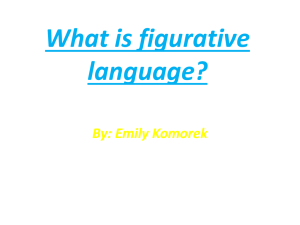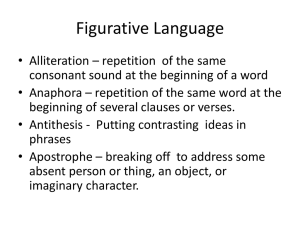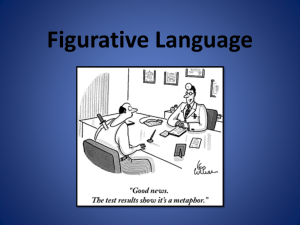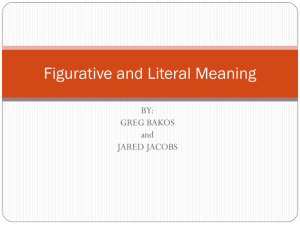Understanding Figurative Language and Idiomatic Expressions
advertisement
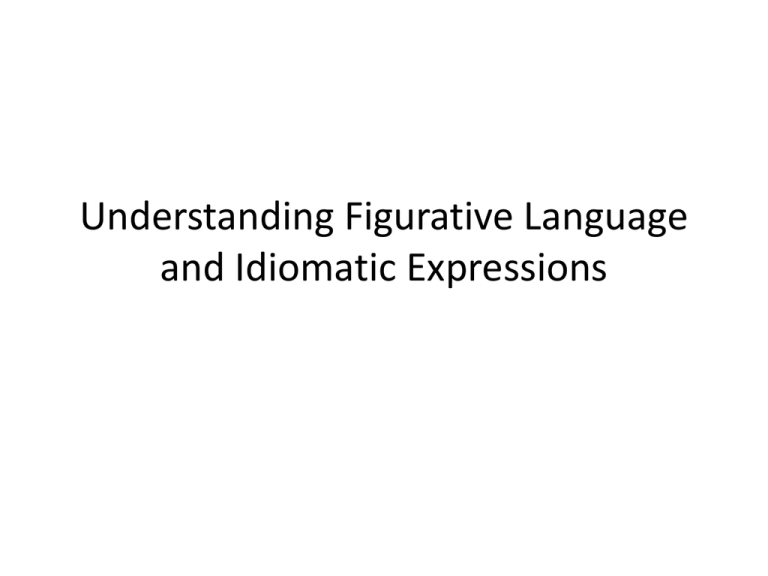
Understanding Figurative Language and Idiomatic Expressions Objectives: • Examine the language structures that may be difficult to interpret. Common Core State Standards: • College and Career Readiness Anchor Standards for Reading K-12: • Craft and Structure: Standard 4. Interpret words and phrases as they are used in a text, including determining technical, connotative, and figurative meanings, and analyze how specific word choices shape meaning or tone. College and Career Readiness Anchor Standards for Language K-12: Knowledge of Language 3. Apply knowledge of language to understand how language functions in different contexts, to make effective choices for meaning or style, and to comprehend more fully when reading or listening. College and Career Readiness Anchor Standards for Language K-12: Vocabulary Acquisition and Use 5. Demonstrate understanding of figurative language, word relationships, and nuances in word meanings. CCSS note on range and content of student language use: To build a foundation for college and career readiness in language, students must … come to appreciate that words have nonliteral meanings, shadings of meaning, and relationships to other words; and expand their vocabulary in the course of studying content. Why focus on migrant students? • Migrant students often have had different experiences that may cause them to understand and interpret text differently from students with other background experiences. • 57% of migrant students in Washington state considered English Language Learners who may not have the language background to understand nuances in English Reading Skills • Readers who comprehend well need to simultaneously interpret: words Reading Comprehension phrases Metacognitive strategies sentences Connections between sentences Discourse structure Paragraph structure Integration with knowledge of self and the world “Digging for Meaning: Teaching Text Comprehension” by Louisa Motes and Nancy Hennessy Why is academic text difficult? Written academic language has: • • • • • • • • More prepositions or meaning units in a sentence Longer sentences with embedded clauses Unusual or low-frequency vocabulary Vocabulary specific to a topic domain Conventional usage and grammar Paragraph structure Tighter logic and less redundancy Fewer conversational clues “Digging for Meaning: Teaching Text Comprehension” by Louisa Motes and Nancy Hennessy Words are metaphorical • Words often don’t mean exactly what they say. • A phrase may mean something not at all like its individual words. “bite the bullet” “quit horsing around” “do an about face” • These expressions can be misinterpreted easily by migrant students, Ells, literal thinkers, or people without the background knowledge to understand the metaphorical meaning. Several types of figurative language: • • • • • • • • Onomatopoeia Personification Similes Metaphors Hyperboles Puns Colloquial Expressions Idioms Onomatopoeia: "Plop, plop, fizz, fizz, oh what a relief it is." An onomatopoeia poem by Lee Emmett of Australia : water plops into pond splish-splash downhill warbling magpies in tree trilling, melodic thrill whoosh, passing breeze flags flutter and flap frog croaks, bird whistles babbling bubbles from tap “Onomatopoeia” by Todd Rundgren "Onomatopoeia every time I see ya My senses tell me hubba And I just can't disagree. I get a feeling in my heart that I can't describe. . . It's sort of whack, whir, wheeze, whine Sputter, splat, squirt, scrape Clink, clank, clunk, clatter Crash, bang, beep, buzz Ring, rip, roar, retch Twang, toot, tinkle, thud Pop, plop, plunk, pow Snort, snuck, sniff, smack Screech, splash, squish, squeak Jingle, rattle, squeal, boing Honk, hoot, hack, belch." Figurative Language: Personification Figurative Language: Similes • The snow is like a blanket. • The bread is as hard as nails. • The river is as dry as a bone. • The football player is bigger than a refrigerator. • She was so surprised that her eyes were as big as saucers. Figurative Language: Metaphors – He was drowning in a sea of grief. – She is fishing in troubled waters. – Her spirit is an unsinkable ship. – The town was covered by a blanket of snow. – Her heart froze when she heard the creaking noise. – Time flies. Figurative Language: Hyperboles Hyperbole in Ads Can You Identify the Company? • • • • • • • Reach out and touch someone. The happiest place on earth. It's so easy, a caveman can do it. It gives you wings! Cover the earth. It’s everywhere you want to be. How good is our steak? Last week a man who was choking on a piece refused the Heimlich maneuver. • • • • • • -AT&T - Disneyland - Geico - Redbull - Sherwin Williams - Visa • - 321 East Figurative Language: Puns • Why are fish so smart? • • What do you get from a pampered • cow? • How do turtles talk to each other? • • Why did the spider go to the • computer? • What do baseball players eat on? • • Time flies like an arrow. Fruit flies… • • Headline: Energizer Bunny arrested, • • • He bought a donkey because … Because they live in schools Spoiled milk On shell phones! To check his web site Home plates! like a banana. charged with battery. he thought he might get a kick out of it. Figurative Language: Colloquial Expressions: • are used in casual speech – I could care less. – That dress just isn’t you. – She’s really over the hill now. – Let’s take a selfie. – Hey, bro, back off! Get outta my grill! – My brother just got plutoed from his job. – She’s a dedicated locavore. – She is well-known for her truthiness. Figurative Language: Idioms • Idioms: figurative expressions that aren’t easily translated and can’t be taken literally – – – – – – – This excused absence note looks fishy. This class is a piece of cake. I can’t believe the hero of the story kicked the bucket! It’s raining cats and dogs. My dogs are really barking today! I heard it through the grapevine. My eyes were bigger than my stomach. Cognitive Content Dictionary: One way to teach idioms – – – – – Introduce the expression and write it on a CCD chart Poll the class. Who has heard it before? Who hasn’t? Have teams predict the meaning of the idiom Repeat the expression several times Give a synonym and signal motion to help students remember it – Use the idiom as a transition signal throughout the day – Ensure that the expression is encountered in context, used, and reinforced during the class Cognitive Content Dictionary – Day 2 • Review the idiom, synonym, and signal • Give the dictionary definition and a studentexplanation • Teams produce a sentence or example showing another way to use the expression, thus showing their understanding of the expression • Reinforce the meaning by using the expression whenever it is appropriate Several types of figurative language: • • • • • • • • Idioms Similes Metaphors Colloquial Expressions Puns Personification Onomatopoeia Hyperboles Teaching Tips: • Recognize figurative language in a text and explain it directly. • Give more examples of how the expression is used. • Ask students to paraphrase the idea in their own words. • Ask students to use the expression themselves. • Create a visual/nonverbal representation of the meaning. “Digging for Meaning: Teaching Text Comprehension” by Louisa Motes and Nancy Hennessy You Try It! • • • • • Group yourselves by grade level. Look at the sample lesson you are given. What do you like about it? What would you do differently? Make a list of the materials you already use that include figurative language. • How you could teach figurative language using those materials?




